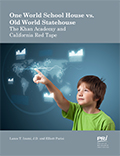 The Pacific Research Institute, a free-market think tank based in San Francisco, released a new report today highlighting the successes of the Khan Academy, including improved learning and significant cost savings. The report also discusses the bureaucratic obstacles that hold back its expansion in California and makes recommendations for removing such obstacles. Download One World School House vs. Old World Statehouse: The Khan Academy and California Red Tape by PRI Senior Director of Education Studies and Koret Senior Fellow Lance Izumi J.D., and research fellow Elliott Parisi.
The Pacific Research Institute, a free-market think tank based in San Francisco, released a new report today highlighting the successes of the Khan Academy, including improved learning and significant cost savings. The report also discusses the bureaucratic obstacles that hold back its expansion in California and makes recommendations for removing such obstacles. Download One World School House vs. Old World Statehouse: The Khan Academy and California Red Tape by PRI Senior Director of Education Studies and Koret Senior Fellow Lance Izumi J.D., and research fellow Elliott Parisi.
The Khan Academy, started by San Francisco resident and former hedge fund analyst Salman Khan, combines straightforward instructional videos and interactive software on math, science, history, economics and other subjects to provide both fundamental learning and higher order education. Mr. Khan encourages using a flipped classroom structure, where students view lecture-like instructional videos at home or some other non-classroom venue, which then allows class time in schools to be used for students working on problems, teachers working with students one-on-one or in small groups, and students working with each other on problems and projects.
In pilot programs conducted among fifth and seventh grade classrooms in the Los Altos school district in Silicon Valley, student achievement on state math exams improved in both grades, and relative to the year before, their average on grade level exam improved by 106 percent. The Khan Academy is also being piloted in several California charter schools.
Cost Savings
According to Mr. Izumi, the Khan Academy could also save valuable tax dollars by allowing teachers to spend half of the time previously spent on whole-class instruction and allow for more time spent on dynamic/personalized learning. As a result, the school would not need as many teachers since the whole-group lectures could be overseen by a less costly learning-lab para-professional.
Mr. Izumi writes that despite the successes of the Khan Academy and other digital learning tools, barriers exist in its expansion and integration in California. The success of the Khan Academy in the schools is hampered by the monopolistic grip of government on the school system and its ability to shut out innovators like Khan. Many educators falsely believe that the Khan Academys success cannot be replicated in other school districts. Moreover, the various regulations and laws that require a minimum number of classroom-based minutes per school day and/or a minimum percentage of classroom-based instruction impede its expansion, Mr. Izumi said.
Mr. Izumi provides several recommendations for successful integration of the Khan Academy in California:
- Schools should award credit for mastering subject matter rather than mere seat time
- Students should be allowed to prove their competency over content either through state standard-aligned tests or through a combination of tests and other rigorous achievement-indicating instruments, and
- Changing the funding formula to follow the child to online or blended-learning courses.
Mr. Izumi concludes: The success of innovative online programs, such as the Khan Academy, is dependent on the implementation of large-scale school choice reforms in the state of California. While the bureaucratic red tape of education continues to debate the flipped classroom philosophy, California should repeal the statutory cap on charter schools and encourage the establishment of more charters that may make the best use of the Khan Academy and other digital learning programs.

